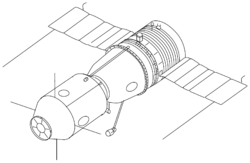Kosmos 613
| Kosmos 613 (Космос-613) | |
| Modell | Sojuz 7K-T |
|---|---|
| NSSDC-ID | 1973-096A[1] |
| Uppskjutning | |
| Startplats | Bajkonur 1/5 |
| Start | 30 november 1973, 05:16:00 UTC |
| Raket | Sojuz |
| Landning | |
| Landning | 29 januari 1974 |
| Omloppsbana | |
| Apogeum | 295 km |
| Perigeum | 195 km |
| Banlutning | 51.6° |
| Besättning | |
| Besättning | Obemannad |
Kosmos 613 (ryska: Космос-613) var en flygning i det Sovjetiska rymdprogrammet. Farkosten sköts upp med en Sojuz-raket, från Kosmodromen i Bajkonur, den 30 november 1973.
Den återinträdde i jordens atmosfär och landade i Sovjetunionen den 29 januari 1974.
Det var ett obemannat långtidstest.
Referenser
- ^ ”NASA Space Science Data Coordinated Archive” (på engelska). NASA. https://nssdc.gsfc.nasa.gov/nmc/spacecraft/display.action?id=1973-096A. Läst 28 februari 2020.
| |||||||||||||||||||||||||||||||||||||||||||||||||||||||||||||||||||||||||||||||||||||||||
Media som används på denna webbplats
Soyuz-TM spacecraft. Compare the antennas on the orbital module to those on Soyuz-T. Differences reflect the change from the Igla rendezvous system used on Soyuz-T to the Kurs rendezvous system used on Soyuz-TM.
Apollo-Soyuz Test Project (ASTP) Soyuz. The APAS-75 docking unit is located at left.
The Soyuz TMA-04M spacecraft is seen after being rolled out by train to the launch pad at the Baikonur Cosmodrome in Kazakhstan, May 13, 2012. The launch of the Soyuz spacecraft, with Expedition 31 Soyuz Commander Gennady Padalka, Flight Engineer Sergei Revin of Russia and NASA Flight Engineer Joe Acaba, is scheduled for 9:01 a.m., May 15 (Kazakhstan time).
Soyuz-A manned spacecraft concept (1963). It was to have been part of the Soyuz A-B-C circumlunar complex.









